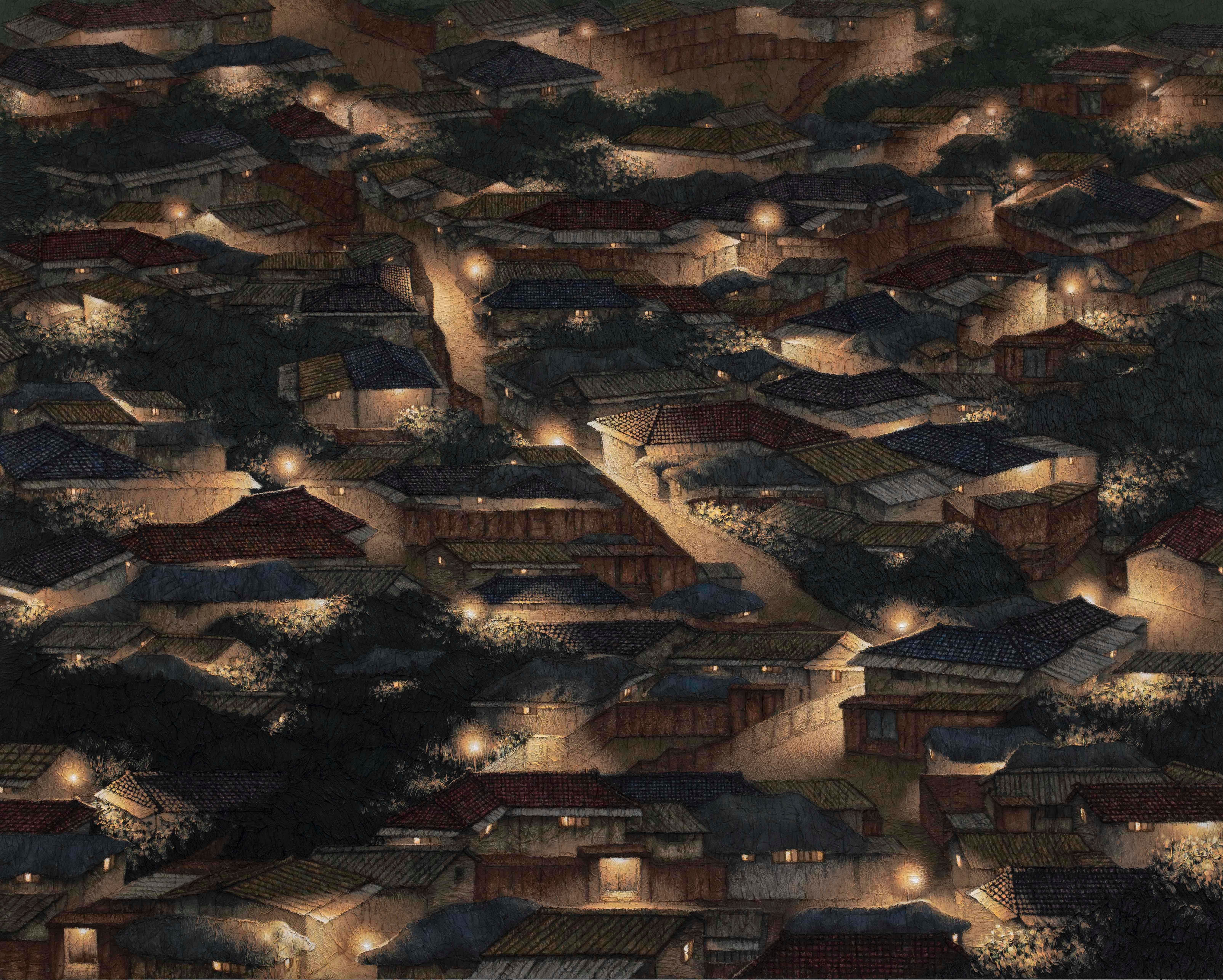
The Korean artist Youngju Joung spent her childhood years intricately drawing the buildings in her South Korean village, before studying Fine Art in Paris. After graduating, she returned to her native Korea, where she climbed the legendary Nam Mountain, and found artistic inspiration in the distant warm flickering lights of downtown of Seoul, dimly lit at dusk. Her paintings are rooted these experiences and are deeply symbolic of Korean society, with her depictions of the city or the hill village reflecting upon poverty and affluence. Softly lit at twilight, her works capture urban and rural scenes that stretch beyond view, speckled with flickering lights that hint at a dense yet unseen human presence. These paintings – painted upon crumpled and layrered Hanji, a type of traditional Korean paper – do not beautify or exaggerate, they are raw representations of exposed bricks, slate rooftops and rusted gates. The medium of hanji itself, and her unique method of incorporating it, has itself endured a wearing process, just as the buildings it represents. The homes are reflections of their occupants, and, seen through a prism of dusk and decay, they transmit a fleeting moment of natural beauty before darkness descends. At the centre of this peaceful transition lies a sacred domestic routine, where each light represents a life, faintly glowing amongst the hum of the living city. Here, the artist shares her inspiration with House Collective, and tells us why the concept of home represents fundamentally human values, and how a catholic childhood instilled a belief in eternity.
What was your first encounter with art, and how did it inspire you to follow the path of the artist?
My first encounter with works of art was through a collection of world masterpieces that my mother bought me when I was young. The book contained numerous works throughout art history, and even when I saw it with my young eyes, I didn't know why, but Da Vinci's portrait sketches felt incredibly realistic and moving, so I copied them and admired them. They were so amazing that I couldn't believe they were human skills. I still envy his genius. Monet also has a dreamy feel, and Millet has only a few representative works, but I felt that my usual thoughts and beliefs were similar in that sense of wanting to leave behind an authentic and high-quality work, even if it was only one work. When I was young, my teacher saw my drawings and recommended that I major in art. I also liked drawing, so I always drew and won many awards.

Where does the title of your current show, Way Back Home come from?
Well, the theme of the exhibition is the disappearing hometown. Home means hometown to me, and hometown symbolizes the most fundamental human beauty, warmth, safety, and mother's embrace. In other words, it means restoring the disappearing humanity. I hope you regain your warm humanity and feel a sense of stability when you see the work. It is not a scenery that actually exists, but a scenery in my imagination, where sadness and warmth coexist, because it reminds me of my childhood when I saw the scenery of the shanty town during difficult times. If you immerse yourself in the work and walk down the street, wouldn’t your childhood memories come back to life and you would get a feeling of hometown and feel warm in your heart?

Talk to us about Hanji paper – why do you use ths material?
I have been using Hanji since I studied abroad in France, and it is a means of expressing my identity as a Korean. Hanji is an everyday material that was used on walls and doors in the past. I lived at my grandmother's house in the countryside for a long time when I was young, so I am very familiar with that house. I believe that everything in everyday life can become material for art. For my current work, I needed a material with a warm feel, and it immediately reminded me of Hanji.

What is the significance of how you use light in the works?
The house symbolises people, and the light symbolizes things like hope and warm comfort. The colour of light represents the emotional atmosphere of memories, and the intention was to feel various emotions depending on the colour of light. The light in the work is an element of hope, and is expressed at the end. It means that there is bright hope at the end of difficult times. My religion when I was young was Catholic, and although I am not religious now, I still believe in eternity and the power of the spirit.
Youngju Joung’s exhibition Way Back Home runs at Almine Rech London until 21 December 2024. Find out more here